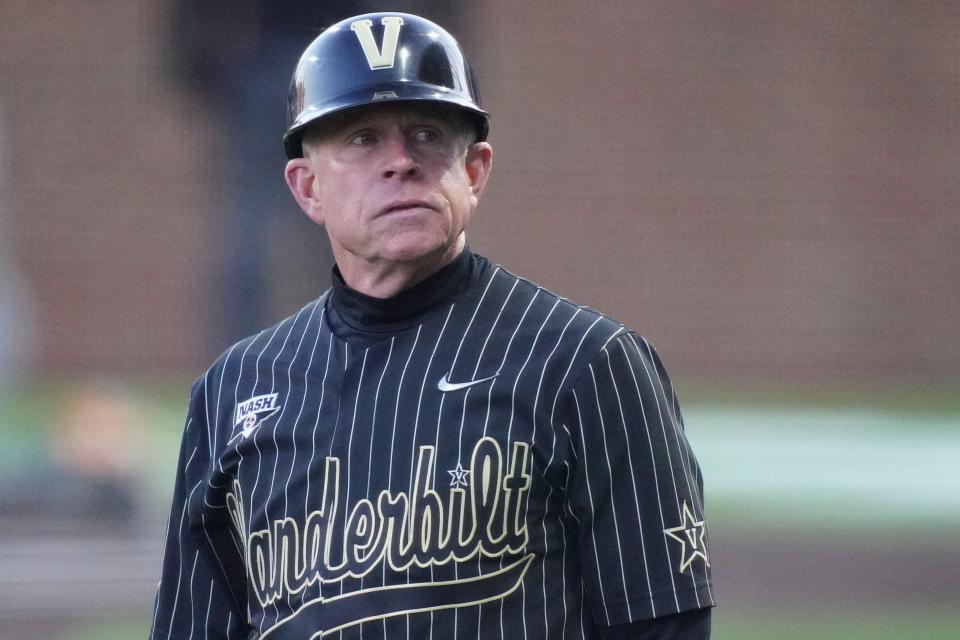Vanderbilt baseball recruiting: How much attrition is normal?
- Oops!Something went wrong.Please try again later.
Vanderbilt baseball had 15 players enter the transfer portal this offseason, second-most among SEC schools. But the Commodores, accustomed to hauling in top recruiting classes year after year, are used to attrition.
In the past 10 seasons, 38% of Vanderbilt's high school recruits who made it to campus either transferred or left the team before completing their college careers. Every recruiting class in that span had at least 20% attrition, and three classes lost 50% or more of their original high school recruits. While the attrition rate has increased in recent years due to the NCAA's decision to let players transfer without sitting out a year, even before that attrition was common due to how difficult it is to make the Commodores' loaded rosters.
Of 53 players who transferred or left the team for Vanderbilt in the past 10 years, 46 (87%) did not have a single season with the Commodores in which they had more than 100 plate appearances or more than 25 innings pitched.
ROSTER ANALYSIS: Examining Vanderbilt baseball's 2023 roster: Who's gone, who's back, who will step up?
TOP ARM COMING: Vanderbilt baseball recruit Andrew Dutkanych withdraws from MLB Draft, will pitch for Commodores
Anatomy of a successful class
Since 2012, four Vanderbilt recruiting classes have lost fewer than 30% of their recruits who made it to campus. Those classes came in 2012, 2015, 2017 and 2019.
The 2012 class was one of the most successful in school history, including future first-round picks Carson Fulmer, Walker Buehler and Dansby Swanson, who formed the core of the 2014 and 2015 teams that went to back-to-back College World Series finals as well as the 2013 team that had the best record in SEC history. The success undoubtedly helped the class stick together; of the three players in that class who transferred, all redshirted their first year before leaving for more playing time.
Like the 2012 class, the 2015 class was packed with future starters like Julian Infante, Ethan Paul, Connor Kaiser and Stephen Scott, many of whom stayed the full four years. Just three of 15 players in that class transferred, and one of those, Kiambu Fentress, spent four years at Vanderbilt before grad transferring to Nevada.

Perhaps the most successful class from an attrition standpoint, however, was 2019's. Players in that class had more opportunity to leave than others due to the one-time transfer exception ratified in 2021, but so far just four of the 15 members of that class, 27%, have left: Carter Young, Maxwell Romero, Will Duff and Ryan Keenan.
Like with 2012 and 2015, a large part of the 2019 class's success was unusually good player identification. Eight members of the class (including Young) were multi-year starters or key bullpen arms, including Jack Leiter, Spencer Jones, Nick Maldonado, Chris McElvain, CJ Rodriguez, Parker Noland and Thomas Schultz. The majority of those players played large roles as freshmen, making them more likely to be satisfied.
BUILDING STRATEGY: Should Vanderbilt baseball, Tim Corbin take more transfers? One College World Series team shows how
Unsuccessful classes
Another part of the success in keeping the 2019 class together, however, was likely the heavy attrition from the previous class in 2018. That class had 14 players get to campus; in the four years since, 10 either transferred or left the team (including Brett Hansen, who did not join the team until 2020). The majority of these players left even before the transfer exception was passed. Austin Becker, John Malcom, Justyn-Henry Malloy, Makenzie Stills and Sterling Hayes had minimal playing time before leaving in 2019 or 2020. The biggest losses of that group were Isaiah Thomas, who was a two-year starter before leaving the team in the summer of 2021, and Ethan Smith, a key bullpen arm who transferred to Tennessee.
Even with the heavy losses, though, the four players who stuck around from that class were key members. Kumar Rocker was one of the top pitchers in program history, Luke Murphy became a lockdown closer who was vital in the 2021 postseason, and Dominic Keegan and Tate Kolwyck were multi-year starters who became senior leaders of the 2022 team. The success of the 2019 class covered for the attrition of 2018 and opened more roles for the 2019 class to find roles early.
The future
With one-time transfers allowed and a shorter MLB Draft leading to more top recruits on campus, and thus more of a roster crunch, it seems that the Commodores will need to get used to lots of attrition from players who don't play much early in their careers. Fifteen of 33 players in the 2020 and 2021 recruiting classes have already left, though Christian Little was the only one from those classes who was a key contributor. Seven of the 15 who left had at least one season in which they did not make the active roster.
In this era, where players tend to leave if they have a hard time envisioning playing time, properly identifying recruits out of high school becomes more important. That's how Vanderbilt can get another class like 2019, where the majority stuck around despite the new transfer rules because they became contributors early on. With fewer draft opportunities to go around, more players are transferring in order to improve their stock.
Although attrition has increased. If the Commodores can hold on to their most important players, they will likely stay in good shape.
Aria Gerson covers Vanderbilt athletics for The Tennessean. Contact her at agerson@gannett.com or on Twitter @aria_gerson.
This article originally appeared on Nashville Tennessean: Vanderbilt baseball recruiting: Attrition common in transfer era

